【公开课教案】仁爱版八年级下册unit5 topic 1 sectionA教学设计
- 格式:doc
- 大小:447.50 KB
- 文档页数:9
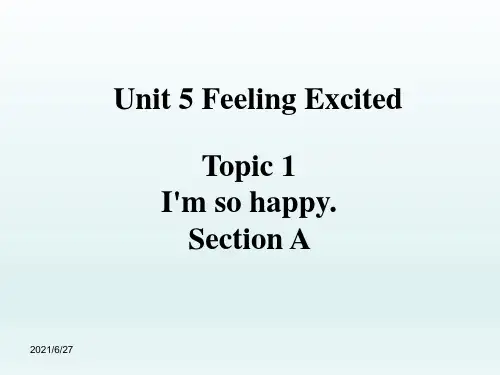
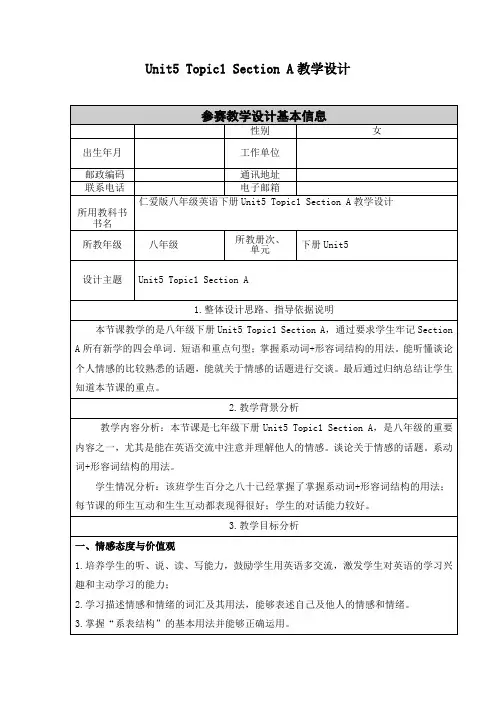
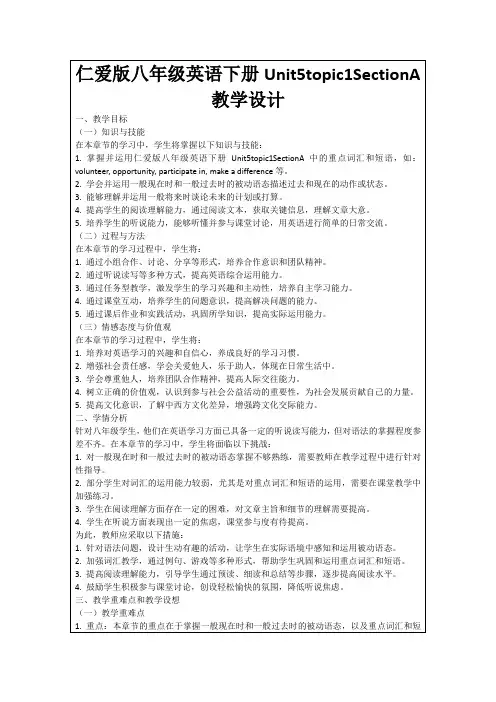

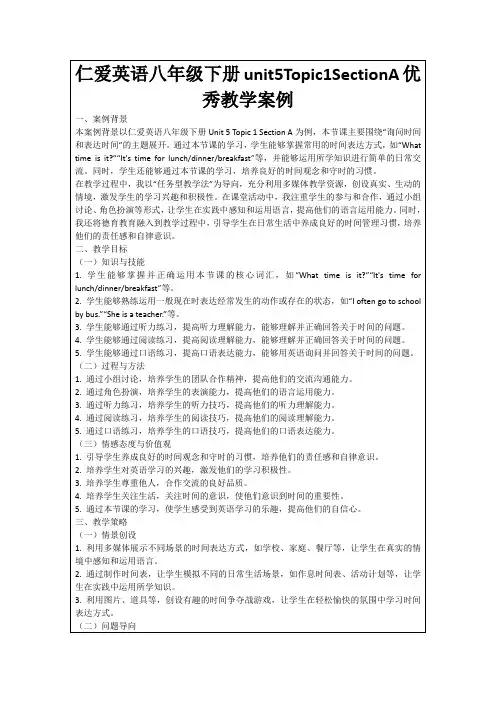
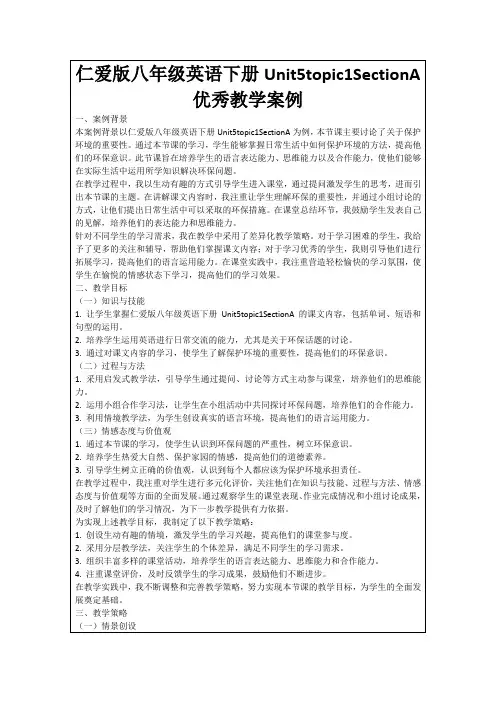
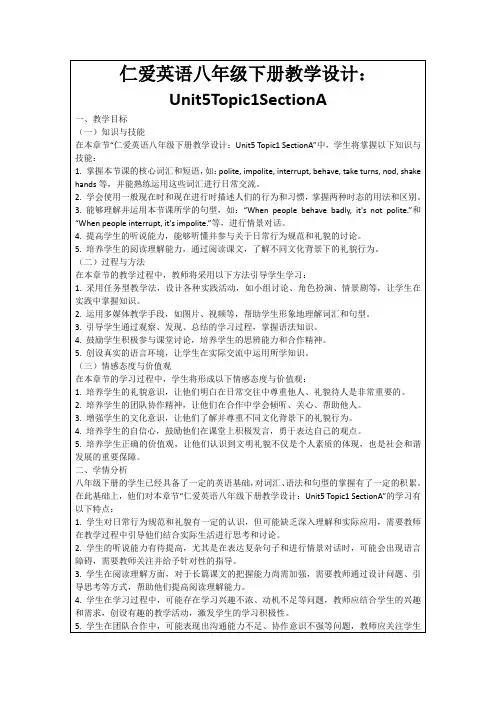
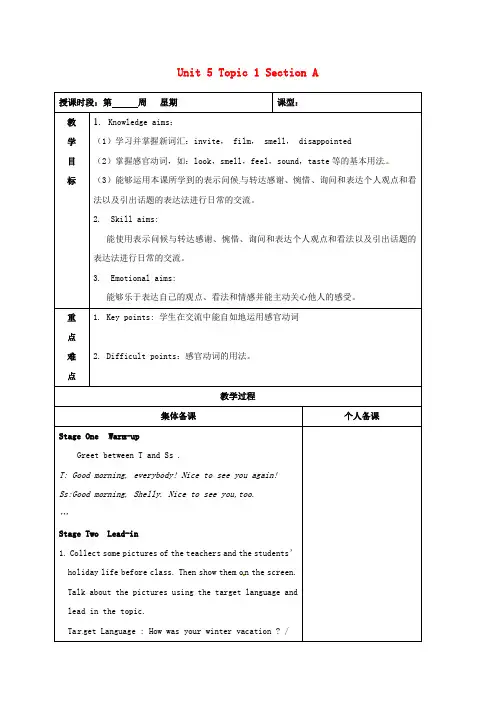
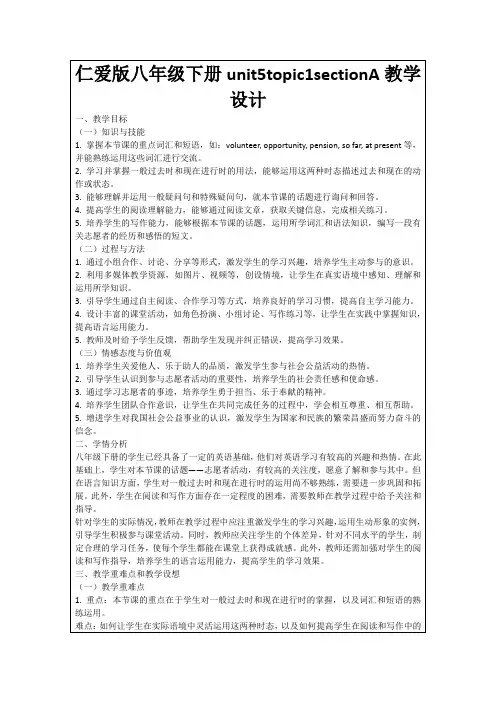
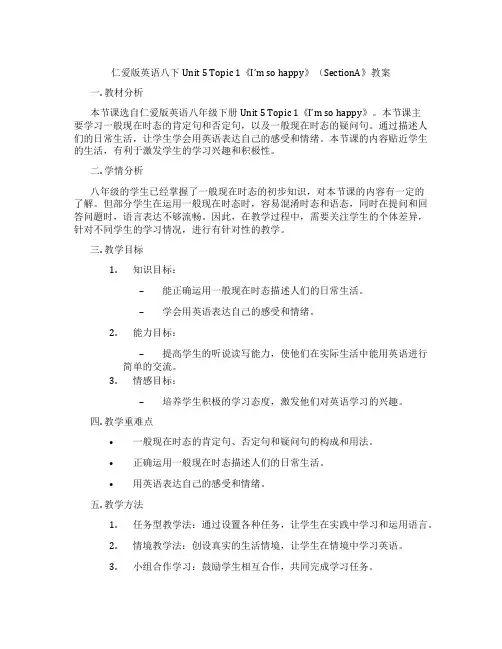
仁爱版英语八下Unit 5 Topic 1《I’m so happy》(SectionA》教案一. 教材分析本节课选自仁爱版英语八年级下册Unit 5 Topic 1《I’m so happy》。
本节课主要学习一般现在时态的肯定句和否定句,以及一般现在时态的疑问句。
通过描述人们的日常生活,让学生学会用英语表达自己的感受和情绪。
本节课的内容贴近学生的生活,有利于激发学生的学习兴趣和积极性。
二. 学情分析八年级的学生已经掌握了一般现在时态的初步知识,对本节课的内容有一定的了解。
但部分学生在运用一般现在时态时,容易混淆时态和语态,同时在提问和回答问题时,语言表达不够流畅。
因此,在教学过程中,需要关注学生的个体差异,针对不同学生的学习情况,进行有针对性的教学。
三. 教学目标1.知识目标:–能正确运用一般现在时态描述人们的日常生活。
–学会用英语表达自己的感受和情绪。
2.能力目标:–提高学生的听说读写能力,使他们在实际生活中能用英语进行简单的交流。
3.情感目标:–培养学生积极的学习态度,激发他们对英语学习的兴趣。
四. 教学重难点•一般现在时态的肯定句、否定句和疑问句的构成和用法。
•正确运用一般现在时态描述人们的日常生活。
•用英语表达自己的感受和情绪。
五. 教学方法1.任务型教学法:通过设置各种任务,让学生在实践中学习和运用语言。
2.情境教学法:创设真实的生活情境,让学生在情境中学习英语。
3.小组合作学习:鼓励学生相互合作,共同完成学习任务。
六. 教学准备1.教材:仁爱版英语八年级下册Unit 5 Topic 1《I’m so happy》。
2.多媒体设备:投影仪、电脑、音响等。
3.教学课件:根据教学内容制作相应的课件。
4.学习任务单:为学生提供学习任务和练习题。
七. 教学过程1.导入(5分钟)利用图片或实物展示与本节课相关的内容,如日常生活用品、表情等,引导学生用英语进行描述。
激发学生的学习兴趣,营造轻松愉快的课堂氛围。
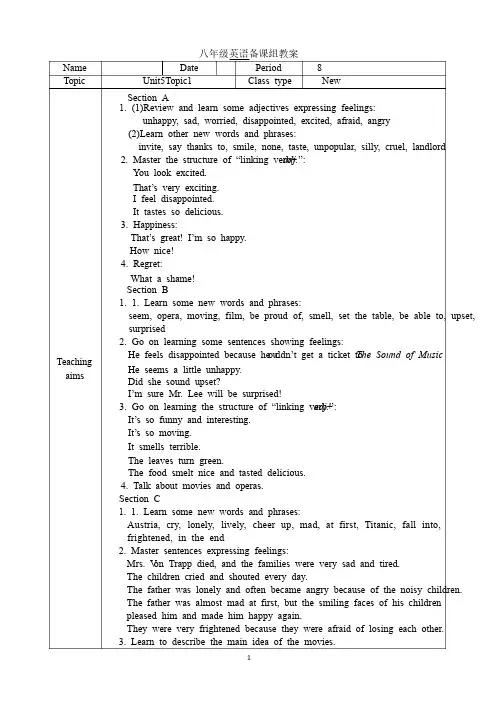
八年级英语备课组教案八年级英语备课组教案Name Date Period 8 Topic Unit5Topic1 Class type New Teaching aims Section A 1. (1)Review and learn some adjectives expressing feelings: unhappy, sad, worried, disappointed, excited, afraid, angry (2)Learn other new words and phrases: invite, say thanks to, smile, none, taste, unpopular, silly, cruel, landlord 2. Master the structure of “linking verb+adj.”:You look excited. That’s very exciting.I feel disappointed. It tastes so delicious. 3. Happiness: That’s great! I’m so happy.How nice! 4. Regret: What a shame! Section B 1. 1. Learn some new words and phrases: seem, opera, moving, film, be proud of, smell, set the table, be able to, upset, surprised 2. Go on learning some sentences showing feelings: He feels disappointed because he couldn’t get a ticket to The Sound of Music. He seems a little unhappy. Did she sound upset? I’m sure Mr. Lee will be surprised!3. Go on learning the structure of “linking verb+adj.”:It’s so funny and interesting.It’s so moving.It smells terrible. The leaves turn green. The food smelt nice and tasted delicious. 4. Talk about movies and operas. Section C 1. 1. Learn some new words and phrases: Austria, Austria, cry, cry, lonely, lively, cheer cheer up, up, up, mad, mad, mad, at at at first, first, first, Titanic, Titanic, fall fall into, into, frightened, in the end 2. Master sentences expressing feelings: Mrs. V on Trapp died, and the families were very sad and tired. The children cried and shouted every day. The father was lonely and often became angry because of the noisy children. The The father father father was was was almost almost almost mad mad mad at at at first, first, first, but but but the the the smiling smiling smiling faces faces faces of of of his his his children children pleased him and made him happy again. They were very frightened because they were afraid of losing each other. 3. Learn to describe the main idea of the movies. 4. Talk about your favorite movies. Section D 1. 1. Learn some new words and phrases: come into being, role, facial, gesture, culture, nowadays, make peace with sb., grateful 2. Learn some knowledge about Beijing Opera: Beijing Opera’s historyfour main roles of Beijing Opera 3. Review and sum up the structure of “linking verb + a dj.adj.”:You look excited. I feel disappointed. It tastes so delicious. The man seems worried. It smells terrible. Did she sound upset? She was very sad and went mad. The father was lonely and often became angry because of the noisy children. 4. Review and sum up the useful expressions in this topic. 5. Learn about Chinese culture and love our national opera. Important points 1.Master the structure of “linking verb+adj.”:You look excited. I feel disappointed. It tastes so delicious. The man seems worried. It smells terrible. Did she sound upset? She was very sad and went mad. 2. Master sentences expressing feelings: Mrs. V on Trapp died, and the families were very sad and tired. The children cried and shouted every day. The father was lonely and often became angry because of the noisy children. Difficult points Master the structure of “linking verb+adj.”You look excited. I feel disappointed. It tastes so delicious. The man seems worried. Teaching steps Section A 备注备注 Review Review Review and and and learn learn learn some some some adjectives adjectives adjectives expressing expressing expressing feelings: feelings: feelings: unhappy, unhappy, sad, worried, disappointed, excited, afraid, angry Lead-in T: Did you have a good time in your winter holiday? Ss: Yes, we did. T: S1, did you ask your friends to your home for dinner? S1: Certainly. T: Oh, Oh, I I I know know know you you you invited invited invited your your your friends friends friends to to to your your your home. home. home. Were Were you ? S1: Yes, we were very happy. T: Great. I know all of you had a good winter holiday. Now let’s use stick figures to express your feelings in the holiday. Check the preview 1. We had a good time in the winter holiday. So we are all happy today. What about Kangkang? 2. 2. Kangkang, Kangkang, Kangkang, Michael, Michael, Michael, Maria Maria Maria and and and Jane Jane Jane are are are happy. happy. happy. What What What about about their teacher, Mr. Lee? Teaching the new lesson 一. 系动词系动词1)状态系动词)状态系动词用来表示主语性质或状态,只有be 一词,例如:一词,例如:He is a teacher.(表示主语的身份)(表示主语的身份)He is ill.(表示主语的状态)(表示主语的状态)2)持续系动词)持续系动词用来表示主语继续或保持一种状况或态度,主要有keep, rest, remain, stay, lie, stand, 例如:例如:He always kept silent at meeting. This matter rests a mystery. 3)表像系动词)表像系动词用来表示"看起来像"这一概念,主要有seem, seem, appear, appear, look, 例如:例如:He looks tired. 他看起来很累。
英语说课稿Unit5 Topic1 SectionAGood morning, my dear judges, I’m number... It’s my great honor to have this opportunity to talk about my teaching ideas. The lesson I teach is Section A, topic1 of Unit 5, You look excited.( 板书标题) My presentation consists of five parts: analysis of teaching materials, teaching aims, teaching methods, teaching procedures and blackboard design. Now I will introduce them one by one.The first part, analysis of teaching materials. The textbook is Middle English, Grade 8, published by Renai Press. This lesson is the first period of Unit 5, which is about feeling excited. It’s a dialogue describing feelings and expressing emotions based on the structure of “Linking verb+adjective”. By study of this topic, students can know how to describe feelings in English.Next, analysis of students. Although junior school students have learned English for several years so far, they are new in middle school. They are curious about new things and have a strong desire to learn better.Part two, teaching aims. First, knowledge and skill aims: students can master some new words and phrases and the structure of “linking verb+adj”. Second, process and method aims: students can develop their listening, speaking, and reading skills and their abilities of working in pairs. The last one, emotional attitude and value aims: students can arouse their interest in learning English and improve the awareness of keeping healthy emotions in life. Based on the teaching materials and teaching aims, the key and difficult points can be designed. The key points are that students can recognize, read and use the new words, phrases, and structures. The difficult points are to describe feelings and express emotions smoothly.Part three, teaching methods and learning methods. In this lesson, I plan to use multimedia teaching methods, task-based activities, and listening training approach. As for the learning methods, I use cooperative learning and autonomous learning. In class, I devide students into several groups to cooperate together to solve problems so as todevelop their cooperative spirit. Sometimes, I require students to solve problems by themselvesto develop their abilities of autonomous learning. Here are the most important part, teaching procedure, it mainly includes 5 steps.Step1 Warming up and Lead inIn this step, I’ll lead in this lesson by showing some pictures through multimedia. I’ll do like this: “Boys and girls, please look at the screen, what can you see? Yes, we can see Kangkang is talking with his friends. Do you know what are they talking about? Ok, it doesn’t matter. Now let’s learn it together.” By doing this, students’ attention can be attracted and the topic can be introduced.Step2 PresentationIn this step, I’ll ask students to listen to the radio for the first time, try to find out the main idea.Then I will let them read the dialogue carefully to find out some key words or phrases.Such as, film, smell, invite to , a ticket to...(板书单词短语) Then I’ll teach them.After that, read again. At the same time, answerthree questions:Q1: How do Jane’s parents feel? Q2:How doesMr.Brown feel? Why? Q3: How does Kangkang feel? Then I will invite some students to answer: “They feel happy.Mr.Brown feels disappointed. Kangkang looks excited” Then let students do pairwork to summerize the structure of “linking verbs + adjective”(板书) Step3 PracticeI’II give students 5 minutes to do pair work to make phrases with the structure “linking verbs + adjective”. Next, I’ll ask students to read the dialogue after the tape, and tell them pay attention to their pronunciation and intonation.Step4 ProductionI plan to ask students to make new conversations in groups according to the example of 2 on the book. For example: “How do the flowers smell?” “They smell nice”Step5 Summary and homeworkAfter production, I’ll guide students to summarize what we have learned today, such as some words,phrases and structures. What’s more, I’ll tell students that we should learn to describe feelings and try to find out their interest in learning English. As a result, the emotional attitude and valuable aims can be achieved. As for the homework, I will ask them to retell the dialogue in their own words and check it next class.The last part of my lesson plan is blackboard design.I write the title in the middle on the top. The news words and phrases are on the left, and the structures are on the right. It’s very clear and easy for students to understand.That’s all for my lesson plan, thank you for your listening.。
Unit 5 Feeling ExcitedTopic 1 You look excitedSection A 2衡阳师范学院祁东附属中学刘惠丹I. Teaching aims:1. Language knowledge1) Learn the adjectives about feelings (happy, sad, angry, excited, disappointed,worried, frightened, upset).2) Learn the linking verbs (feel, smell, taste, look, sound) and learn how to usethe structure “Linking verb + adjective”.2. Learning ability: Students are able to get listening and speaking skills.3. Thinking ability: Learn how to ask and answer questions about feelings and emotions.II. Key points:1.Adjectives about feelings2. The linking verbs.3. The structure “Linking verb + adjective”.III. Difficult points:Use the structure “Linking verb + adjective” to express feelings.IV. Teaching aids:Computer multimedia projectorV. Teaching procedures(整体思路:1. 采用激励和竞赛机制,提升学生的学习兴趣:课堂上将学生分成两部分,每个任务的完成都采用加分制;培养学生自主学习的能力,让学生在各项活动中发挥主体作用;2. 循序渐进推进课堂: 由词语到句子,再到对话,步步深入;3. 突出学生学习能力的培养,让学生通过大量的语言实践,提升语言综合运用能力;4. 注重课堂实效,通过活动和任务让学生的核心素养的培养落到实处。
第一课时Section A (1a—2d)教学目标通过本课的学习,学生能够:1.利用课前准备、当堂书写、语境识记等策略,听懂、朗读并准确识记本课时的重点词汇和常用表达。
(获取信息)2. 利用1c、2c、2d的对话练习,对所听、所读语篇进行梳理,熟练表达在过去某一时刻发生的动作,提高语言表达能力。
(梳理整合)3.利用独立完成1b、2a、2b的听力练习,提取有用信息,提升抓取关键信息的能力,并在创设的情境下运用关于过去的表达创编对话。
(内化应用)4. 读懂关于过去时间的对话语篇并使用所学目标语言描述自己过去发生的事情。
(迁移创新)语篇研读What:本课听力语篇1针对记者的采访,多人讲述了自己在暴风雨来临时正在做的事情。
听力语篇2主要讲述了一个男孩自述昨天一天糟糕的经历,类型为记叙文。
本课对话语篇是Linda和Mary的对话,二人就昨晚未接电话展开的一番对话。
Why:听力语篇1通过被采访者的讲述,表达了人们遭遇暴风雨时的无奈。
听力语篇2通过男孩的自述,读者感受到男孩当时的无助与无奈,也提醒读者凡事应提前做准备,避免意外情况的发生。
对话语篇通过Linda向Mary讲述自己未接到电话的原因以及Mary多次致电的原因,向读者传达在面对困难时应向他人求助,也让读者深切感受到二人之间的情谊。
How:听力语篇1采用采访的方式展开,四人分别讲述自己的故事,结构清晰。
听力语篇2采用自述形式展开,通过男孩一天从早到晚的经历,以时间顺序层层展开,时间标志明显,结构清晰,读者易于理解。
对话语篇采用对话格式讲述原因,语篇结构清晰。
通过问答形式表述二人多次致电及未接电话的原因以及帮助带来的意义。
教学过程设计理念:以新课标核心素养为导向,以单元主题为引领,基于语篇的育人理念,体现新课标“学思用创”的英语学习活动观和“教—学—评”一体化设计理念。
续表续表板书设计作业设计基础型作业:Read 2d again and retell it.实践型作业:Finish the exercise.拓展型作业:Interview your classmate about his or her event happened in the past.Then write it down.教学反思。
最新】仁爱版八年级英语下册unit5topic1.nA教案设计XXX。
XXX。
for sb。
say thanks/goodbye/hello/sorry to sb。
a ticket to…Difficult points:学生能正确使用描述情绪的形容词和交际功能用语。
Ⅳ。
Teaching methodsTask-based language teaching method。
group n。
pair work。
role play。
and XXX.XXX resStep 1.Warm-up1) Greet the students and ask them how they are doing today.2) Play a short video clip of people expressing different nsand ask the students to guess what XXX.Step 2.n1) Introduce the topic of the lesson: describing XXX.2) Play the。
of n A 1a and ask the students to listen and answer the ns: Why is Kangkang excited。
What are Jane's plansfor the evening?3) Play the。
of n A 3 and ask the students to listen and fill in the blanks with the correct words.Step 3.Practice1) Pair work: Ask the students to work in pairs XXX.2) Group n: Ask the students to discuss in groups and share their own XXX.3) Role play: Divide the students into groups and ask them to role play different s where they have to express XXX.Step 4.n1) Ask the students to write a short paragraph about a time when they felt excited。
You look excited中国书法艺术说课教案今天我要说课的题目是中国书法艺术,下面我将从教材分析、教学方法、教学过程、课堂评价四个方面对这堂课进行设计。
本节课讲的是中国书法艺术主要是为了提高学生对书法基础知识的掌握,让学生开始对书法的入门学习有一定了解。
书法作为中国特有的一门线条艺术,在书写中与笔、墨、纸、砚相得益彰,是中国人民勤劳智慧的结晶,是举世公认的艺术奇葩。
早在5000年以前的甲骨文就初露端倪,书法从文字产生到形成文字的书写体系,几经变革创造了多种体式的书写艺术。
1、教学目标:使学生了解书法的发展史概况和特点及书法的总体情况,通过分析代表作品,获得如何欣赏书法作品的知识,并能作简单的书法练习。
2、教学重点与难点:(一)教学重点了解中国书法的基础知识,掌握其基本特点,进行大量的书法练习。
(二)教学难点:如何感受、认识书法作品中的线条美、结构美、气韵美。
3、教具准备:粉笔,钢笔,书写纸等。
4、课时:一课时要让学生在教学过程中有所收获,并达到一定的教学目标,在本节课的教学中,我将采用欣赏法、讲授法、练习法来设计本节课。
(1)欣赏法:通过幻灯片让学生欣赏大量优秀的书法作品,使学生对书法产生浓厚的兴趣。
(2)讲授法:讲解书法文字的发展简史,和形式特征,让学生对书法作进一步的了解和认识,通过对书法理论的了解,更深刻的认识书法,从而为以后的书法练习作重要铺垫!(3)练习法:为了使学生充分了解、认识书法名家名作的书法功底和技巧,请学生进行局部临摹练习。
三、教学过程:(一)组织教学让学生准备好上课用的工具,如钢笔,书与纸等;做好上课准备,以便在以下的教学过程中有一个良好的学习气氛。
(二)引入新课,通过对上节课所学知识的总结,让学生认识到学习书法的意义和重要性!(三)讲授新课1、在讲授新课之前,通过大量幻灯片让学生欣赏一些优秀的书法作品,使学生对书法产生浓厚的兴趣。
2、讲解书法文字的发展简史和形式特征,让学生对书法作品进一步的了解和认识通过对书法理论的了解,更深刻的认识书法,从而为以后的书法练习作重要铺垫!A书法文字发展简史:①古文字系统甲古文——钟鼎文——篆书早在5000年以前我们中华民族的祖先就在龟甲、兽骨上刻出了许多用于记载占卜、天文历法、医术的原始文字“甲骨文”;到了夏商周时期,由于生产力的发展,人们掌握了金属的治炼技术,便在金属器皿上铸上当时的一些天文,历法等情况,这就是“钟鼎文”(又名金文);秦统一全国以后为了方便政治、经济、文化的交流,便将各国纷杂的文字统一为“秦篆”,为了有别于以前的大篆又称小篆。
八年级英语下册Unit5 Topic 1 Section A 教学设计
一、教学课题:Unit 5 Feeling Excited Topic 1 You look excited. Section A
二、教学思路设计
利用图片、多媒体、录音机等创设情景,帮助学生在设定的语言环境运用英语。
在具体教学过程中以学生为主体,采用对话教学策略,使他们在学习过程中主动地用英语表达,达到培养和强化学生的语言实践能力的目的。
三、教材分析
本课是仁爱版八年级英语下册Unit5Topic1You look excited.的第一课时。
本课通过孩子们的对话,呈现了孩子们的高兴以及Mr.Brown没有买到票而失望,引出对话的主题:描述情感与表达对事物的感觉。
对话呈现了有关情感的形容词和短语,同时也呈现了交际功能用语:How are you doing? Very well, thank you.和What a pity! 帮助学生学会如何表达感觉和描述情绪。
要求学生在学会课本语言知识的同时,培养他们的互助互爱的精神,在能够正确处理个人情绪的同时帮助他人排解不良的情绪。
四、学情分析
本人所教的八年级(1)班大多数学生为女生,少部分男生。
由于我校地处农村,这些学生当中绝大部分为农村留守儿童,性格比较内向。
学生英语接受和学习能力比较差,同时没有一个好的语言学习氛围和充足的教学资源,导致班内大多数学生英语基础知识较差,应用能力薄弱,尤其听说能力较差。
对于女生来说,语言类的科目相对掌握得比较好,大部分女生主观学习英语的愿望较强,能做好课前预习,课后复习。
八年级下学期所学的语法知识点比较多,导致部分学生产生了恐惧心理。
上课注意力不够集中,部分学生对英语失去学习兴趣。
大部分学生比较胆小内
向,上课不敢积极发言。
因此,教师在教学中要培养学生学习英语的兴趣,针对不同层次的学生开展不同的教学活动。
五、教学目标
(一)知识目标
1. Key vocabulary:
Master the new words: invite, disappointed, film, smell
Linking Verb: be, smell, feel, look, sound, taste
Some adjective about feelings: excited, happy, disappointed
2. Be able to make sentences with the key phrases:
invite sb. to do sth.
prepare sth. for sb.
say thanks to
a ticket to
3. Learn some useful expressions to describe feelings:
--How are you doing? –Very well, thank you.
Please say thanks to your mom for us.
4. Learn the structure of “Linking Verb + Adjective”
You look excited.
They feel happy..
(二)能力目标
To train students’ listening skill and communication skill.
(三)情感目标
1.Know how to describe feelings and learn to deal with negative feelings.
2.Learn to care about others’ feelings, and help each other to deal with sadness.
六、教学重难点
(一)教学重点:
1. Key words: invite, disappointed, film, smell
Linking Verb: be, smell, feel, look, sound, taste,excited, happy, disappointed Key phrases: invite sb. to do sth, prepare sth. for sb, say thanks to, a ticket to 2. Master the structure of “Linking Verb + Adjective”
(二)教学难点
Use the structure of “Linking Verb + Adjective” to describe feelings.
七、教学方法:
Listening, practicing, situation teaching method, dialog teaching
八、教具:
Recorder, cards and pictures, computer, PPT.
九、教学过程
教学反思:本课主要采取对话策略来进行教学,通过新年这一话题来引起学生兴趣,让学生运用已学过的相关语言知识进行师生对话,引入课文内容。
在课堂上通过师生问答、角色扮演,讨论话题等手段来进行对话教学策略,师生对话,生生对话贯穿整一节课。
本课课文内容较简单,大部分学生能够理解1a, 并且通过跟读1a和各样的对话练习,加深学生对课文理解的同时也锻炼了学生的听说能力。
通过1b、1c、2、3来巩固学生对系表结构的理解与运用,许多学生能够运用系表结构来表达自己的感觉和情绪。
但因为是新学期的第一节新课,少部分同学无法专心听课,有些同学回答问题不够积极大胆,没有直接用英语表达。
改进之处:在今后的课堂上应注意提高学生自信心,鼓励他们开口说英
语。
注意因材施教,多关注不同层次的学生,让他们共同进步。
板书设计:
Unit 5 Feeling Excited
Topic 1 You look excited.
Section A
1.-How are you doing? -V ery well, thank you.
2. a ticket to…
3. invite sb. to do sth.
4. What a pity!
5. prepare sth. for sb.
6.say thanks to sb.
7.系表结构:linking verb + adjective 系动词:look, smell, taste, sound, feel, be。